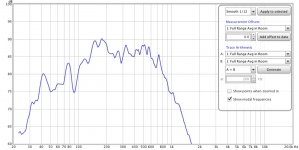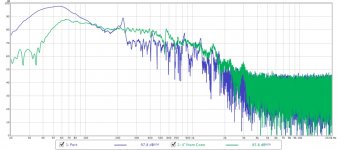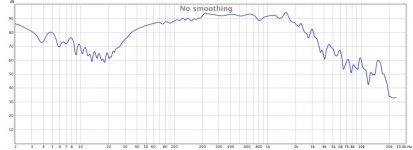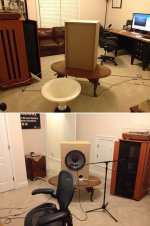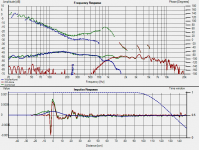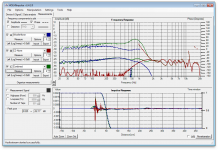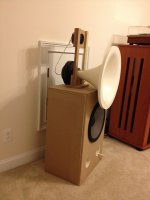1)You wrote "80Hz 6 dB/oct LP" for the 2226, is that a typo for 800 Hz?Woofer peak was 3.58 ms, tweeter 3.808 ms, delay set 0.3 on woofer to align.
2226:
80Hz 6 dB/oct LP
40Hz 12 dB/octave HP
0.3ms delay on woofer (matched IR peaks 1m from center of woofer/CD).
2445:
1000Hz 24 dB/oct HP
EQ:
2226:
60 Hz +4 dB Q2 Peak
160 Hz -6 dB to -8dB Q1 Peak
2445:
6000 Hz +8 dB High-Shelf.
I still do not like the dip at the crossover frequency, I thought that would go away with the time alignment..
At any rate, the acoustical crossover for the 2226 looks low and slow (probably the reason for the dip, I'd suggest matching both around 800 with a 24 dB LR and use a BW 24 at 35 Hz for the 2226. Using a BW for the upper filter on the 2226 may help fill the dip if it still persists.
The 2226 also looks like it needs an out of band PEQ dip around 1200 Hz, though a steeper filter will make that less a problem.
Thanks for the comments -- the 80 Hz was not a typo, it really is that low to counteract the rising midrange response. I'd like to do a higher x-over frequency, like 800 LR4, but I think I will need another solution to tame the midrange and balance out the LF response. I don't want to boost the LF that much, but that is the other option.
The screenshot here is with the LR4 at 800 Hz (again, same 8 position average response.)
I've been exploring the Active Crossover Designer templates to try and work on this, but open to suggestions here as well. I assume the peak in the 40s is the port?
The screenshot here is with the LR4 at 800 Hz (again, same 8 position average response.)
I've been exploring the Active Crossover Designer templates to try and work on this, but open to suggestions here as well. I assume the peak in the 40s is the port?
Attachments
With the tests done in room, hard to assume much.Thanks for the comments -- the 80 Hz was not a typo, it really is that low to counteract the rising midrange response. I'd like to do a higher x-over frequency, like 800 LR4, but I think I will need another solution to tame the midrange and balance out the LF response. I don't want to boost the LF that much, but that is the other option.
I assume the peak in the 40s is the port?
Try measuring with the mic in the port, and another about 4 inches from the cone, with no filters.
Whether you boost LF or cut midrange to achieve a flat response the net effect is the same (for a given SPL), but in your case, considering the 2226 should have pretty flat response room position and/or mic position is probably responsible for the reduced LF response.
A diagram or picture of the measurement positions and shape and size of the room (and adjacent rooms connected by doors or openings) would be helpful.
Last edited:
Thank you for your help, sorry I didn't get these done sooner.
Here are the close-mic measurements. My room is about 14' x 15' with all doors shut (finished attic). There is an entrance that is about 2' wide and 8' across, so the room is a rectangle with an L-outcropping.
These close-mic'd measurements where with the loudspeaker in the center of the room away from any walls.
I also attempted to do a quasi-nearfield measurement in ARTA, where I took a near field measurement between the woofer and port at about 2cm, applied half space to full space free-field amplitude scaling, LF diffraction box calculation and then merged with a gated response at 1m.
Is the spike in the response around 222 Hz the port resonance? Would stuffing the enclosure with fiberglass help attenuate this?
Does my Quasi-anechoic measurement make any sense?
Thank you in advance.
Here are the close-mic measurements. My room is about 14' x 15' with all doors shut (finished attic). There is an entrance that is about 2' wide and 8' across, so the room is a rectangle with an L-outcropping.
These close-mic'd measurements where with the loudspeaker in the center of the room away from any walls.
I also attempted to do a quasi-nearfield measurement in ARTA, where I took a near field measurement between the woofer and port at about 2cm, applied half space to full space free-field amplitude scaling, LF diffraction box calculation and then merged with a gated response at 1m.
Is the spike in the response around 222 Hz the port resonance? Would stuffing the enclosure with fiberglass help attenuate this?
Does my Quasi-anechoic measurement make any sense?
Thank you in advance.
Attachments
1) Looks like a port resonance, being around 10 dB down from the fundamental port output probably not very audible, and may be more of a near field effect.My room is about 14' x 15' with all doors shut (finished attic). There is an entrance that is about 2' wide and 8' across, so the room is a rectangle with an L-outcropping.
1)Is the spike in the response around 222 Hz the port resonance?
2)Would stuffing the enclosure with fiberglass help attenuate this?
3)Does my Quasi-anechoic measurement make any sense?
2) Probably not, but fiberglass on the back, one side, and bottom will reduce upper reflections coming out the port (and to some degree reflections re-transmitted through the cone), a good practice for speakers covering bass and midrange.
3) I'm sure it makes sense, but I don't understand it :^).
The near field response confirm that the previous measured bass loss is due to the room, not the speaker response.
Near square room dimensions are problematic (especially with the vertical dimension near half the width), and the 2' x 8' "stub" may be a bass trap.
It would be worth a try to close the stub off (piece of plywood, stand up a couch, refrigerator box, whatever) and see if that improves things.
I once closed off a stub in a studio's control room (just using gobos, kind of studio "room dividers") and it eliminated a 10 dB bass "hole" they had near the center of the room where the clients usually sat.
Art
Last edited:
Art --
Thanks for taking the time to respond. I will will stuff the enclosure and remeasure to see what that does.
This is what I was doing with the gated measurements:
https://sites.google.com/site/frostespeakers/arta-information
Was trying to prepare to use the FRD blender and Active Crossover Designer.
FRD Blender (from scaled a LF diffraction-correct Near-field and gated far-field FRDs:
FRD Response Blender and Minimum Phase Extractor is now available
ACD:
the Active Crossover Designer web page
Good Idea on closing the stub, I will give that a try and see what happens. Should get some more measurement time tonight, and will report back.
Thanks for taking the time to respond. I will will stuff the enclosure and remeasure to see what that does.
This is what I was doing with the gated measurements:
https://sites.google.com/site/frostespeakers/arta-information
Was trying to prepare to use the FRD blender and Active Crossover Designer.
FRD Blender (from scaled a LF diffraction-correct Near-field and gated far-field FRDs:
FRD Response Blender and Minimum Phase Extractor is now available
ACD:
the Active Crossover Designer web page
Good Idea on closing the stub, I will give that a try and see what happens. Should get some more measurement time tonight, and will report back.
I do not recommend "stuffing" the cabinet, just fiberglass on the back, one side, and bottom, if still too live, line all the walls.Art --
Thanks for taking the time to respond. I will will stuff the enclosure and remeasure to see what that does.
Good Idea on closing the stub, I will give that a try and see what happens. Should get some more measurement time tonight, and will report back.
Have fun!
New Crossover Settings
Woofer:
LP BW 12 @ 1000 Hz
HP LR 12 @ 30 Hz
+4 dB 60 Hz Q2 Peak
Tweeter:
HP BW 12 @ 1000 Hz -- CDs sound MUCH better with a 12 dB/octave slope.
No EQ needed on CDs.
Much better efficiency here in this setup. Tweeter is trimmed - 4 dB, Polarity is inverted because of the 12 dB crossover slope.
Woofer output delay is 0.4 ms.
Woofer:
LP BW 12 @ 1000 Hz
HP LR 12 @ 30 Hz
+4 dB 60 Hz Q2 Peak
Tweeter:
HP BW 12 @ 1000 Hz -- CDs sound MUCH better with a 12 dB/octave slope.
No EQ needed on CDs.
Much better efficiency here in this setup. Tweeter is trimmed - 4 dB, Polarity is inverted because of the 12 dB crossover slope.
Woofer output delay is 0.4 ms.
CDs sound MUCH better with a 12 dB/octave slope.
It's now over a thousand pages and years long but the Beyond the Ariel thread has covered most of the issues that you are encountering in one form or another.
I'd start by filtering down to post just by the thread owner as the SNR is pretty shocking.
Another likely useful thread is Quasi-optimal" crossover for high-efficiency loudspeaker system which looks closely at the latest work in cross overs below 200Hz
It's now over a thousand pages and years long but the Beyond the Ariel thread has covered most of the issues that you are encountering in one form or another.
I'd start by filtering down to post just by the thread owner as the SNR is pretty shocking.
Another likely useful thread is Quasi-optimal" crossover for high-efficiency loudspeaker system which looks closely at the latest work in cross overs below 200Hz
Thank you for the quasi-optimal thread, that is very helpful. I'm interested in trying some of the topologies there, but wonder if I can implement in my MiniDSP.
3rd order Butterworth Low Pass, -3dB @ Fx*0.87 (+)
3rd order Butterworth High Pass, -3dB @ Fx*1.15 (-)
Offset = 0.22*c/Fx
4th order L-R Low Pass, -6dB @ Fx (+)
3rd order Bessel High Pass, -3dB @ Fx*1.4 (-)
Offset = 0.29*c/Fx
4th order L-R Low Pass, -6dB @ Fx (+)
4th order L-R High Pass, -6dB @ Fx (-)
Offset = 0.31*c/Fx
6th order Bessel Low Pass, -6dB @ Fx*1.25 (+)
2nd order Butterworth High Pass, -3dB @ Fx*1.3 (-)
Offset = 0.40*c/Fx
6th order L-R Low Pass, -6dB @ Fx * 1.06 (+)
3rd order Butterworth High Pass, -3dB @ Fx* 1,13 (-)
Offset = 0.445 c/Fx
6th order L-R Low Pass, -6dB @ Fx * 1.07 (+)
4th order L-R High Pass, -6dB @ Fx * 0.92 (-)
Offset = 0.465 c/Fx
I understand the slopes and the crossover frequency modifiers, but I don't understand the Offset. Does that mean how much offset that the x-over provides through phase shift from the woofer to the tweeter? If so, I am looking for about 0.3ms due to the woofer being physically in front of the CD at 1000 Hz? Correct?
Thank you very much for all your help.
the crossover frequency modifiers, but I don't understand the Offset.
I must confess that I am still doing my home work on this one (must finish my current project before starting on the subs) - I think it is the physical offset required to get the filter to work as advertised.
Thanks @Thoglette
Here is a measurement with the La Clech 3rd/3rd crossover. Needed to add an additional .2ms delay on the woofer to get them to sum correctly, but I think this is a pretty smooth response in the crossover region.
Pretty interesting problem, these CDs + Direct radiating woofers. Nice that the miniDSP affords me the ability to try out these different crossover without having to buy more components.
Sound is noticeably smoother, especially piano and solo acoustical guitar. Still needing to do some pre-crossover EQ (so as not to mess up the phase response.) Adding a bit of a bass boost and a cut around 250Hz.
This is the best sounding crossover to date.
Here is a measurement with the La Clech 3rd/3rd crossover. Needed to add an additional .2ms delay on the woofer to get them to sum correctly, but I think this is a pretty smooth response in the crossover region.
Pretty interesting problem, these CDs + Direct radiating woofers. Nice that the miniDSP affords me the ability to try out these different crossover without having to buy more components.
Sound is noticeably smoother, especially piano and solo acoustical guitar. Still needing to do some pre-crossover EQ (so as not to mess up the phase response.) Adding a bit of a bass boost and a cut around 250Hz.
This is the best sounding crossover to date.
This is the best sounding crossover to date.
Certainly looks pretty good. Glad to hear it sounds that way too!
Worked on a draft mounting system for the supertweetrs and to stabilize the CDs. Came up with this. Not completely thrilled with it but it solves two problems:
1) Supertweeter (2405H) is now aligned with the CD and clears the horn physically. Able to drop the high EQ in MiniDSP, because now everything is bright and clear with the 2405H.
2) CD is now positioned in a bracket and the horn is no longer resting on the front of the cabinet.
Hopefully will get some measurements of the whole system tomorrow. Since I am using a passive 2nd order crossover on the 2405H, I ended up flipping the polarity on the input of it. I'll confirm this via measurement tomorrow, and also this bracket will let me set a repeatable and measurable offset between the woofer and CD.
1) Supertweeter (2405H) is now aligned with the CD and clears the horn physically. Able to drop the high EQ in MiniDSP, because now everything is bright and clear with the 2405H.
2) CD is now positioned in a bracket and the horn is no longer resting on the front of the cabinet.
Hopefully will get some measurements of the whole system tomorrow. Since I am using a passive 2nd order crossover on the 2405H, I ended up flipping the polarity on the input of it. I'll confirm this via measurement tomorrow, and also this bracket will let me set a repeatable and measurable offset between the woofer and CD.
Attachments
I'd suggest mounting the 2405 baffle in front of the upright supports and rounding the edges to reduce diffraction.Worked on a draft mounting system for the supertweetrs and to stabilize the CDs.
Alternatively, foam "waveguides" could be placed on either side of the slot exit, as the 2405 is way wider dispersion at the crossover point than the mid horn, limiting the horizontal dispersion will make for a more uniform sound throughout the crossover region.
Also would put absorptive foam, fiberglass or organic material on the upper back side of the mid horn to reduce the high frequency reflections from its surface.
Alternatively, an absorptive foam "shelf" (wire braces could support it) could be placed between the bottom of the 2405 and the top of mid horn, the shelf following the mid horn arc.
Would also recommend rounding the corners of the mid horn if you don't plan on recess mounting it to a baffle in the future.
Art
Last edited:
@danvprod. What a great project! I am impressed with your miniDSP knowledge. What tools are you using to measure the speaker's output?
- Status
- Not open for further replies.
- Home
- Loudspeakers
- Multi-Way
- Open Baffle and JBL compression drivers design help
